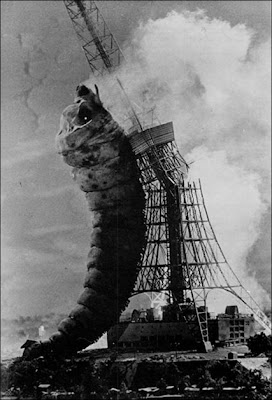 30. Mothra
30. MothraSince her first film, Mothra has been depicted in various stages of the lepidopteran life cycle: Mothra's mammoth egg is decoratively colored in blue and yellow waves. The egg hatches into her larva, a massive brown, segmented caterpillar (resembling a silkworm) with glowing blue—red when angry—eyes. In rare circumstances, twins may emerge from the egg. The caterpillar eventually spins a silken cocoon around itself (the pupa stage), and from this cocoon the imago (adult) Mothra emerges, a gigantic moth-like creature with brightly-colored wings. Mothra's life cycle—particularly the tendency of an imago's death to coincide with its larvae hatching—echoes that of the Phoenix, resembling resurrection and suggesting divinity. Despite having wrought destruction worthy of any Toho daikaiju, she is almost always portrayed as a kind and benevolent creature, causing destruction only when acting as protector to her worshipers on Infant Island or to her egg, or as collateral damage while protecting Earth from a greater threat. She has also fertilized her own eggs.
Mothra has proven a formidable adversary in combat: in larval form she may use her silken spray to wrap and immobilize an opponent, and has a knack for biting and clinging to foes' tails. In imago form her powers vary widely from film to film, including very animalistic scratching and dragging, incorporating several bolt and beam weapons in the Heisei era, and often concluding with a poisonous yellow powder (or "scales") —her last defense.
Mothra is one of the most powerful psychics in the Toho universe. She has had the ability to use this power benevolently, to communicate with humans, or aggressively, to destroy her enemies. As suggested earlier, Mothra is assumed to be divine and draws many parallels to the Phoenix, which makes her one of the more powerful kaiju of the Toho universe.
Mothra has become one of Godzilla's more challenging opponents, having achieved the greatest success rate in battle save Godzilla himself[4]: She has once rid of Godzilla in imago form, and twice Godzilla has fought her to the death only later to be bested by her newborn larvae. It should be mentioned that Mothra has never beaten Godzilla alone (in her Imago Form). The only close to draw by an insect(s), but still won by Godzilla were the Mothra twin-larvae in Godzilla vs. Mothra in the Showa Era, Imago Mothra and Imago Battra in Godzilla and Mothra: The Battle for Earth in the Heisei series, and the twin-larvae and Kiryu (MechaGodzilla) in the Millennium Series.
Mothra is the only kaiju other than Godzilla, Junior, and Mecha-King Ghidorah to appear in more than one Heisei Godzilla movie as she appears in Godzilla vs. Spacegodzilla when she sends her Cosmos and Fairy Mothras to help out Miki.
In the Heisei Era (1984–1995), Mothra gained her own series of films dubbed in America as the Rebirth of Mothra series (Rebirth of Mothra, Rebirth of Mothra II, and Rebirth of Mothra III). In Japan, the series is simply called the "Mothra Series"(Mothra, Mothra 2: Adventure Under the Sea, and Mothra 3: Attack of Grand King Ghidorah). These series are not connected to the Showa, Heisei or Millennium Godzilla movies and are standalone films aiming towards children. The movies start off as the last Mothra puts the last of her energy into a new egg. From this egg hatches Mothra Leo.
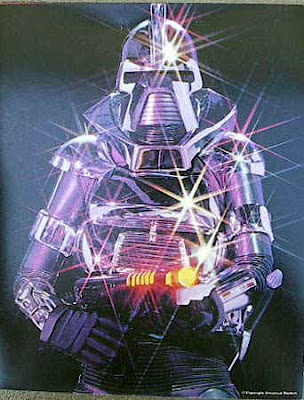 29. The Cylons
29. The CylonsCylons are a fictional race of robots in the original Battlestar Galactica TV series. They are the primary antagonists of the series and are at war with the Twelve Colonies of humanity. The Cylons also appeared in the short-lived 1980 spin-off series Galactica 1980.
The Cylons were created by a reptilian race, also called Cylons. However, the reptilian race died out centuries earlier leaving behind only their race of robots.
In the 1978 Galactica movie and series and the 1980 spin-off, the Cylons were created by an extinct reptilian race that were also called Cylons, as related by Apollo in the premiere episode. In the episode "War of the Gods", Count Baltar mentions that he recognizes Iblis's voice as that of the Cylon leader, and Iblis counters that if that was true it must have been "transcribed" over a thousand yahren (years) ago.
At the beginning of the series the Cylons are singularly devoted to the destruction of humanity. The war started when the Cylon Empire sought to expand into the territory of the Hasaries, and the Human Colonies intervened on behalf of the conquered Hasaries. Due to those events, the Cylon Empire now viewed the entire human race as a target.
Cylons are led by the Imperious Leader, an IL-Series Cylon elevated to a supreme leadership position over all Cylons. All Cylons from the IL-series down, typically repeat the phrase "By Your Command" when responding to any order.
The Cylon Empire is also responsible for tributary powers under the aegis of the Cylon Alliance. The Ovions (an insectoid race enslaved by the Cylons and transported to the planet Carillon for mining purposes) are the only known member of the Cylon Alliance shown onscreen. Aside from the Ovions and (the defeated) Hasaries, the only other known race conquered by the Cylons are the Delphians, which are mentioned to have been exterminated in "The Living Legend".
Cylon society appears to be almost exclusively military. Until the discovery of Gamoray, which the Colonial fleet had targeted for its rich fuel reserves, no civilian Cylon outpost had ever been seen by anyone.
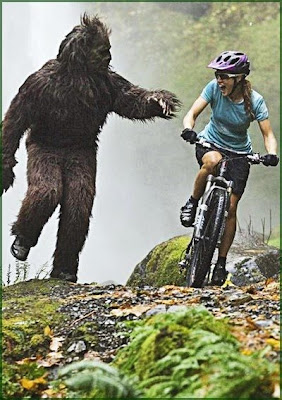 28. Bigfoot
28. BigfootBigfoot, or Sasquatch, an alleged ape-like creature purportedly inhabiting forests, mainly in the Pacific Northwest region of North America, has had a demonstrable impact as a popular culture phenomenon. It has "become entrenched in American popular culture and it is as viable an icon as Michael Jordan" with more than forty five years having passed since reported sightings in California, and neither an animal nor "a satisfying explanation as to why folks see giant hairy men that don't exist."
Examples of Bigfoot in Films:
The Legend of Boggy Creek is a 1972 horror docudrama about the "Fouke Monster", a Bigfoot-type creature that has been seen in and around Fouke, Arkansas since the 1950s. The film mixes staged interviews with some local residents who claim to have encountered the creature, along with fictitious reenactments of said encounters. Charles B. Pierce, an advertising salesman from Texarkana on the Arkansas/Texas border, borrowed over $100,000 from a local trucking company, used an old movie camera and hired locals (mainly high school students) to help make the 90-minute film. It has generated approximately $20 million in revenue and can be found on DVD.
Snowbeast is a made-for-television horror film that was first broadcast in 1977 in The United States of America. The movie details the attacks of a ravenous sasquatch on a Colorado ski resort. The teleplay was written by Joseph Stefano, who wrote the script for Alfred Hitchcock's classic 1960 thriller Psycho. Stefano reportedly used a book by Roger Patterson (who claimed to have encountered a bigfoot in 1967) as his primary inspiration, though no credit is given.
Curse of Bigfoot is a 1978 American film directed by Dave Flocker.
The film is an expanded version of the 1958 film Teenagers Battle the Thing. The two stars from the original appear as adults in the opening scene of the 1978 film. The rest of Curse of Bigfoot consists of the entire 1958 film seen as a flashback.
A college Biology class receives a visitor, who is a good friend of their teacher. He tells them of an encounter that he and their teacher had 20 years before while searching for Indian artifacts in the nearby mountains. They find a mummified corpse in a cave that resembles a rough-hewn statue. The mummy is brought back to their lodge and breaks out of its wrappings. It goes on a short rampage in what appears to be an orchard. The humans gather together to stop the creature before it can kill any one.
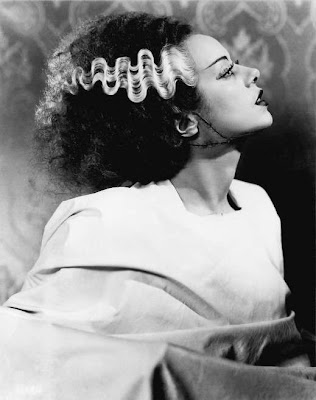 27. The Bride
27. The BrideBride of Frankenstein (advertised as The Bride of Frankenstein) is a 1935 American horror film, the first sequel to the influential Frankenstein (1931). Bride of Frankenstein was directed by James Whale and stars Boris Karloff as The Monster, Elsa Lanchester in the dual role of his mate and Mary Shelley, Colin Clive as Henry Frankenstein and Ernest Thesiger as Doctor Septimus Pretorius.
The film follows on immediately from the events of the first film, and is rooted in a subplot of the original novel, Frankenstein (1818). In the film, a chastened Henry Frankenstein abandons his plans to create life, only to be tempted and finally coerced by the Monster, encouraged by Henry's old mentor Dr. Pretorius, into constructing a mate for him.
On a stormy night, Percy Bysshe Shelley (Douglas Walton) and Lord Byron (Gavin Gordon) praise Mary Shelley (Elsa Lanchester) for her story of Frankenstein and his Monster. Reminding them that her intention was to impart a moral lesson, Mary says she has more of the story to tell. The scene shifts to the end of the 1931 Frankenstein.
Villagers gathered around the burning windmill cheer the apparent death of the Monster (Boris Karloff, credited as "Karloff"). Their joy is tempered by the realization that Henry Frankenstein (Colin Clive) is also apparently dead. Hans (Reginald Barlow), father of the girl the creature drowned in the previous film, wants to see the Monster's bones. He falls into a pit underneath the mill, where the Monster strangles him. Hauling himself from the pit, the Monster casts Hans' wife (Mary Gordon) into it to her death. He next encounters Minnie (Una O'Connor), who flees in terror.
Henry's body is returned to his fiancée Elizabeth (Valerie Hobson) at his ancestral castle home. Minnie arrives to sound the alarm about the Monster but her warning goes unheeded. Elizabeth, seeing Henry move, realizes he is still alive. Nursed back to health by Elizabeth, Henry has renounced his creation but still believes he may be destined to unlock the secret of life and immortality. A hysterical Elizabeth cries that she sees death coming, foreshadowing the arrival of Henry's former mentor, Doctor Septimus Pretorius (Ernest Thesiger). In his rooms, Pretorius shows Henry several homunculi he has created, including a miniature queen, king, archbishop, devil, ballerina and mermaid. Pretorius wishes to work with Henry to create a mate for the Monster and offers a toast to their venture: "To a new world of gods and monsters!"
The Monster saves a young shepherdess (Anne Darling) from drowning; her screams upon seeing him alert two hunters, who shoot and injure the creature. The hunters raise a mob that sets out in pursuit. Captured and trussed to a pole, the Monster is hauled to a dungeon and chained. Left alone, he breaks his chains and escapes.
That night the Monster encounters a gypsy family and burns his hand in their campfire. Following the sound of a violin playing "Ave Maria", the Monster encounters an old, blind hermit (O. P. Heggie), who thanks God for sending him a friend. He teaches the monster words like "friend" and "good" and shares a meal with him. Two lost hunters stumble upon the cottage and recognize the Monster. He attacks them and accidentally burns down the cottage as the hunters lead the hermit away.
Taking refuge from another angry mob in an underground crypt, the Monster spies Pretorius and his cronies Karl (Dwight Frye) and Ludwig (Ted Billings) breaking open a grave. The henchmen depart; Pretorius stays to enjoy a light supper. The Monster approaches Pretorius, and learns that Pretorius plans to create a mate for him.
Henry and Elizabeth, now married, are visited by Pretorius; he is ready for Henry to do his part in their "grand collaboration". Henry refuses and Pretorius calls in the Monster, who demands Henry's help. Henry again refuses and Pretorius orders the Monster out, signaling him to kidnap Elizabeth. Pretorius guarantees her safe return upon Henry's participation. Henry returns to his tower laboratory where, in spite of himself, he grows excited over his work. After being assured of Elizabeth's safety, Henry completes the Bride's body.
A storm rages as final preparations are made to bring the Bride to life. Her bandage-wrapped body is raised through the roof. Lightning strikes a kite, sending electricity through the Bride. Henry and Pretorius lower her and realize their success. "She's alive! Alive!" Henry cries. They remove her bandages and help her to stand. "The bride of Frankenstein!" Doctor Pretorius declares.
The excited Monster sees his mate (Elsa Lanchester) and reaches out to her. "Friend?" he asks. The Bride, screaming, rejects him. "She hate me! Like others," the Monster dejectedly says. As Elizabeth races to Henry's side, the Monster rampages through the laboratory. "Go! You live!" he tells Henry and Elizabeth. To Pretorius and the Bride, he says "You stay. We belong dead." While Henry and Elizabeth flee, the Monster, shedding a tear as the Bride hisses at him, pulls a lever to trigger the destruction of the laboratory and tower.
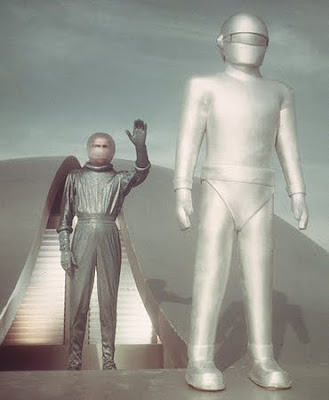 26. Gort
26. GortGort is a fictional humanoid robot in the 1951 film The Day the Earth Stood Still and its 2008 remake.
In the original short story "Farewell to the Master", on which the two films are based, the character was called Gnut.
The eight-foot metal robot accompanies Klaatu, a visitor to Earth from a distant planet, aboard a flying saucer. He does not speak, but uses a beam weapon projected from beneath a visor to vaporize weapons and obstacles. Klaatu describes him as being part of an interstellar police force. He announces that the people of the universe constructed numerous robots like Gort and gave them irrevocable powers to respond to violent actions in order to "preserve the peace." He goes on to say that "There's no limit to what [Gort] could do. He could destroy the Earth."[1]
The character was based loosely on Gnut, a large green robot from outer space in "Farewell to the Master", a 1940 short story by Harry Bates which was used as the basis for Edmund H. North's screenplay. In the story, Gnut is believed to be the servant of his humanoid companion, but reveals himself, at the end, to have been the master.
On screen Gort is a large "seamless" robot that appears to be constructed from a single piece of "flexible metal". He was portrayed by 7'-7" (231 cm)-tall actor Lock Martin wearing a thick foam-rubber suit designed and built by Addison Hehr. Two suits were created, fastened alternately from the front or back so that the robot could appear seamless depending on the camera angle. Another fiberglass statue of Gort was used for close-ups of him firing his beam weapon or when the scene did not call for him to move. In order to maximize the height of the robot, the costume was made with lifts in the boots and was designed so that the figure's helmet stands nearly a foot above the top of Martin's head. Prisms were employed so that Martin could see through the costume's visor and air holes were provided under the robot's chin.
During most of the film, Gort remains motionless in front of the saucer, which rests on the National Mall in central Washington D. C. while scientists and military researchers examine him. At one point Klaatu communicates with him using signals from a flashlight. He also responds to spoken commands, including the famous line "Gort! Klaatu barada nikto!", spoken by Patricia Neal's character at the film's climax.
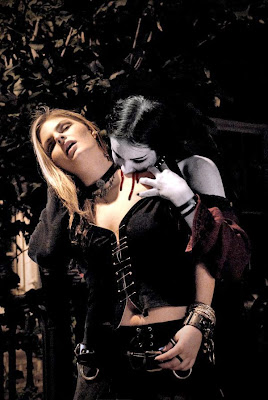 25. Vampires
25. VampiresVampire films have been a staple since the silent days, so much so that the depiction of vampires in popular culture is strongly based upon their depiction in movies throughout the years. The most popular cinematic adaptation of vampire fiction has been from Bram Stoker's Dracula, with over 170 versions to date. Running a distant second are adaptations of Carmilla by Sheridan Le Fanu. The legend of Elizabeth Báthory, the "Blood Countess" has also been an influence. By 2005, Dracula had been the subject of more films than any other fictional character.
Early cinematic vampires in such films as The Vampire (1913), directed by Robert G. Vignola, were not undead bloodsucking fiends but 'vamps'. Such femme fatales were inspired by a poem by Rudyard Kipling called "The Vampire", composed in 1897. This poem was written as kind of commentary on a painting of a female vampire by Philip Burne-Jones exhibited in the same year. Lyrics from Kipling's poem: A fool there was . . . , describing a seduced man, were used as the title of the film A Fool There Was (1915) starring Theda Bara as the 'vamp' in question and the poem was used in the publicity for the film.
An authentic supernatural vampire features in the landmark Nosferatu (1922 Germany, directed by F. W. Murnau) starring Max Schreck as the hideous Count Orlok. This was an unlicensed version of Bram Stoker's Dracula, based so closely on the novel that the estate sued and won, with all copies ordered to be destroyed. It would be painstakingly restored in 1994 by a team of European scholars from the five surviving prints that had escaped destruction. The destruction of the vampire, in the closing sequence of the film, by sunlight rather than the traditional stake through the heart proved very influential on later films and became an accepted part of vampire lore.
The next classic treatment of the vampire legend was in Universal's Dracula (1931) starring Béla Lugosi as Count Dracula. Five years after the release of the film, Universal released Dracula's Daughter (1936), a direct sequel that starts immediately after the end of the first film. A second sequel, Son of Dracula, starring Lon Chaney, Jr. followed in 1943. Despite his apparent death in the 1931 film, the Count returned to life in three more Universal films of the mid-1940s: House of Frankenstein (1944), House of Dracula (1945) both starring John Carradine and Abbott and Costello Meet Frankenstein (1948). While Lugosi had played a vampire in two other movies during the 1930s and 1940s, it was only in this final film that he played Count Dracula on-screen for the second (and last) time.
A transition between the Universal tradition and the later Hammer style is exemplified by the 1957 Mexican movie El Vampiro that actually showed the vampire fangs (Universal did not).
Dracula was reincarnated for a new generation in the celebrated Hammer Films series, starring Christopher Lee as the Count. In the first of these films Dracula (1958) the spectacular death of the title character through being exposed to the sun, reinforced this part vampire lore, first established in Nosferatu, and made it virtually axiomatic in succeeding films.[2] Lee returned as Dracula in all but two of the seven sequels. A more faithful adaptation of Stoker's novel appeared as Dracula (1992) directed by Francis Ford Coppola though also identifying Count Dracula with the notorious medieval Balkan ruler Vlad the Impaler.
A distinct sub-genre of vampire films, ultimately inspired by Le Fanu's Carmilla explored the topic of the lesbian vampire. Although implied in Daughter of Dracula, the first openly lesbian vampire was in Blood and Roses (1960) by Roger Vadim. More explicit lesbian content was provided in Hammer's Karnstein Trilogy. The first of these, The Vampire Lovers, (1970), starring Ingrid Pitt and Madeline Smith, was a relatively straightforward re-telling of LeFanu's novella, but with more overt violence and sexuality. Later films in this sub-genre such as Vampyres (1974) became even more explicit in their depiction of sex, nudity and violence.
Beginning with Abbott and Costello Meet Frankenstein (1948) the vampire has often been the subject of comedy. The Fearless Vampire Killers (1967) by Roman Polanski was a notable parody of the genre. Other comedic treatments, of variable quality, include Vampira (1974) featuring David Niven as a lovelorn Dracula, Love at First Bite (1979) featuring George Hamilton and Dracula: Dead and Loving It (1995), directed by Mel Brooks) with Leslie Nielsen.
Another development in some vampire films has been a change from supernatural horror to science fictional explanations of vampirism. The Last Man on Earth (1964, directed by Ubaldo Ragona), The Omega Man (1971 USA, directed by Boris Sagal)and two other films were all based on Richard Matheson's novel I Am Legend. They explain the condition as having a natural cause. Vampirism is explained as a kind of virus in David Cronenberg's Rabid (1976) and Red-Blooded American Girl (1990) directed by David Blyth.
Race has been another theme, as exemplified by the blaxploitation picture Blacula (1972) and several sequels.
Since the time of Béla Lugosi's Dracula (1931) the vampire, male or female, has usually been portrayed as an alluring sex symbol. Christopher Lee, Delphine Seyrig, Frank Langella, and Lauren Hutton are just a few examples of actors who brought great sex-appeal into their portrayal of the vampire. Latterly the implicit sexual themes of vampire film have become much more overt, culminating in such films as Gayracula (1983) and The Vampire of Budapest, (1995), two pornographic all-male vampire movies, and Lust for Dracula (2005), a pornographic all-lesbian adaptation of Bram Stoker's classic.
There is, however, a very small sub-genre, pioneered in Murnau's seminal Nosferatu (1922) in which the portrayal of the vampire is similar to the hideous creature of European folklore. Max Schrek's disturbing portrayal of this role in Murnau's film was copied by Klaus Kinski in Werner Herzog's remake Nosferatu the Vampyre (1979). In Shadow of the Vampire (2000). directed by E. Elias Merhige, Willem Dafoe plays Max Schrek, himself, though portrayed here as an actual vampire. Dafoe's character is the ugly, disgusting creature of the original Nosferatu. Stephen King's Salem's Lot (1979), notably depicts vampires as terrifying, simple-minded creatures, without erotism, and with the only desire to feed on the blood of others. This type of vampire is also featured in the film 30 Days of Night.
A major character in most vampire films is the vampire hunter, of which Stoker's Abraham Van Helsing is a prototype. However, killing vampires has changed. Where Van Helsing relied on a stake through the heart, in Vampires 1998, directed by John Carpenter, Jack Crow (James Woods) has a heavily-armed squad of vampire hunters, and in Buffy the Vampire Slayer (1992 , directed by Fran Rubel Kuzui), writer Joss Whedon (who created TV's Buffy the Vampire Slayer and spin-off Angel) attached The Slayer, Buffy Summers (Kristy Swanson in the film, Sarah Michelle Gellar in the TV series), to a network of Watchers and mystically endowed her with superhuman powers.
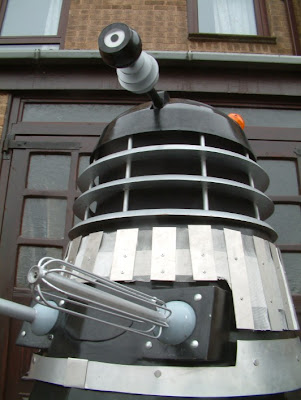 24. The Daleks
24. The DaleksThe Daleks (pronounced /ˈdɑːlɛks/ ( listen)) are a fictional extraterrestrial race of genetically manipulated mutants from the British science fiction television series Doctor Who. Within the series, Daleks are cyborgs from the planet Skaro, created by the scientist Davros during the final years of a thousand-year war against the Thals. They are mutated Kaleds integrated within a tank-like or robot-like mechanical casing. The resulting creatures are a powerful race bent on universal conquest and domination, utterly without pity, compassion or remorse. Various storylines portray them as having had every emotion removed except hate, leaving them with a desire to purge the Universe of all non-Dalek life. Occasionally they are shown as experiencing other emotions, primarily fear, although such occurrences are rare. Collectively they are the greatest enemies of the series' protagonist, the Time Lord known as the Doctor. Their famous catchphrase is "Exterminate!", with each syllable individually synthesised in a frantic electronic voice.
The Daleks were created by writer Terry Nation and designed by BBC designer Raymond Cusick. They were introduced in December 1963 in the second Doctor Who serial, colloquially known as The Daleks. They became an immediate and huge hit with viewers, featuring in many subsequent serials and two 1960s motion pictures. They have become as synonymous with Doctor Who as the title character, and their behaviour and catchphrases are now part of British popular culture. "Hiding behind the sofa whenever the Daleks appear" has been cited as an element of British cultural identity; and a 2008 survey indicated that 9 out of 10 British children were able to identify a Dalek correctly. In 1999 a Dalek appeared on a postage stamp celebrating British popular culture, photographed by Lord Snowdon. In 2010, readers of science fiction magazine SFX voted the Dalek as the all-time greatest monster, beating out competition including Japanese movie monster Godzilla and J. R. R. Tolkien's Gollum, of The Lord of the Rings.
The word "Dalek" has entered major dictionaries, including the Oxford English Dictionary, which defines it somewhat imprecisely as "a type of robot appearing in ‘Dr. Who‘, a B.B.C. Television science-fiction programme; hence used allusively." The term is sometimes used metaphorically to describe people, usually figures of authority, who act like robots unable to break from their programming; for example, John Birt, the Director-General of the BBC from 1992 to 2000, was publicly called a "croak-voiced Dalek" by playwright Dennis Potter in the MacTaggart Lecture at the 1993 Edinburgh Television Festival.
 23. Gamera
23. GameraGamera (ガメラ) is a giant, flying turtle from a popular series of kaiju (Japanese giant monster) films produced by Daiei Motion Picture Company in Japan. Created in 1965 to rival the success of Toho Studios' Godzilla during the monster boom of the mid-to-late 1960s, Gamera has gained fame and notoriety as a Japanese icon in his own right.
In the United States, Gamera attained prominence during the 1970s due to the burgeoning popularity of UHF television stations featuring Saturday afternoon matinee showcases like Creature Double Feature and later in the 1990s when several Gamera films were featured on the television program Mystery Science Theater 3000.
In the Shōwa era series, Gamera was a titanic, fire-breathing prehistoric species of tortoise who fed on flames, reawakened by an accidental atomic blast in the Arctic during an aerial assault by US fighters on Soviet bombers caught crossing into North American airspace. The narrative points out that Gamera had appeared in the past, revealed in an ancient stone etching. Gamera was already capable of flight and breathing fire (rather than atomic rays like Godzilla) when he was reawakened.
In the Heisei era series, however, the origin of Gamera was tweaked to make the theme much more directly heroic: a bio-engineered Guardian of the Universe created by Atlantis with the purpose of defeating Gyaos, another ancient creation capable of killing all human life. The giant turtle is found floating adrift in the Pacific, encased in rock and mistaken for an atoll. Within the rock, investigators discover a large monolith explaining Gamera's purpose, as well as dozens of magatama, which allow a psychic link between Gamera and humans. In the third film of the series, an undersea graveyard is found with many other Gamera fossils, suggesting Gamera was not the only member of his kind created. One character in the film refers to these fossils as "beta versions" of Gamera, possible failures in Atlantis' attempts to create the final version. Another scene provides Gamera with a link to Asian folklore, with a character relating a story in which a giant tortoise is considered the Guardian of the North, with separate, rival creatures defending the East, West and South.
Gamera's continuity was rebooted again in the only film of the Millennium era. The film begins with the original Gamera sacrificing himself to destroy several Gyaos in 1973. 33 years later, a young boy finds a strange, glowing red rock near his home, with a small egg lying on top of it. A fairly normal looking baby tortoise soon hatches from the egg, but begins to grow at an alarming rate. The turtle, now named "Toto" by his preadolescent owner, quickly develops Gamera's classic abilities to breathe fire and fly, and attempts to ward off another attacking monster, Zedus, but is too weak to succeed. Only after eating the glowing rock found with his egg does the new Gamera achieve his full power, defeating Zedus and flying off into the sky.
 22. The Apes
22. The ApesPlanet of the Apes is a 1968 American science fiction film directed by Franklin J. Schaffner and based on the novel La planète des singes by Pierre Boulle, released in 1963. The film stars Charlton Heston and features Roddy McDowall, Kim Hunter, Maurice Evans, James Whitmore, James Daly and Linda Harrison. It was released by 20th Century Fox.
The film tells the story of an astronaut crew who crash land on a strange planet in the distant future. Although the planet appears desolate at first, the surviving crew members stumble upon a society in which apes have evolved into creatures with human-like intelligence and speech. The apes have assumed the role of the dominant species and humans have been subjugated into slavery.
Astronauts Taylor (Heston), Landon (Robert Gunner), Stewart (Dianne Stanley), and Dodge (Jeff Burton) are in deep hibernation when their spaceship crash-lands in a lake on an unknown planet in the year 3978 A.D. after a 2006-year voyage at near-light speed (during which the crew ages only 18 months due to time dilation). The planet has no moon and the clouds at night are luminous. The astronauts awaken to find Stewart's decomposed body, and that their ship is sinking. They use an inflatable raft to reach shore. Once there, Dodge performs a soil test and pronounces the soil incapable of sustaining life. Taylor suggests they are on a planet in the constellation of Orion some 320 light years from Earth but admits he is not sure.
The three astronauts set off through the desert, finding first a single plant and then others. They find an oasis at the edge of the desert where they decide to go swimming, ignoring strange 'scarecrows'. While they are swimming, their clothes are stolen. Pursuing the thieves, the astronauts find their clothes in shreds and the perpetrators — a group of mute, primitive humans — contentedly raiding a cornfield. Suddenly, gorillas on horseback charge through the cornfield, brandishing firearms, snares, and nets, which they use to capture whatever humans they can and kill those they cannot. While fleeing, Dodge is killed, Landon is bashed in the head and knocked unconscious, and Taylor is shot in the throat. The gorillas take Taylor to "Ape City," where his life is saved by two chimpanzee scientists,"animal" psychologist Zira (Hunter) and surgeon Galen. Upon awakening, Taylor—now housed in a cage with a girl whom he later calls Nova (Harrison), who was captured on the same hunt—discovers that his throat wound has rendered him temporarily mute.
Taylor discovers that the apes, who can talk, are in control and are divided into a strict class system: the gorillas as police, military, and hunters; the orangutans as administrators, politicians, and lawyers; and the chimpanzees as intellectuals and scientists. Humans, who cannot talk, are considered feral vermin and are hunted and either killed outright, enslaved for manual labor, or used for scientific experimentation.
Zira and her fiancé, Cornelius, an archaeologist, take an interest in Taylor after he tries to communicate by mouthing words. While Cornelius and Zira are talking to their boss, an orangutan named Dr. Zaius (Evans), Taylor writes in the dirt and attempts to call Cornelius and Zira's attention to it. Nova runs her hands over it, to which Taylor pulls her away, but when a primitive man ruins it as well Taylor kicks him away. This angers the man, and he attacks Taylor. A gorilla comes in with a torch and burns Taylor, but only Zaius sees Taylor's writing. Realizing that Taylor is intelligent, he destroys the writing with his cane. Eventually, Taylor steals paper from Zira when she comes close to his cage and uses it to write messages to her. Zira and Cornelius are convinced that Taylor is intelligent; upon learning of this, Zaius orders that Taylor be castrated.
Taylor manages to escape before the procedure can be carried out and flees through Ape City, which he discovers to be an architecturally primitive version of 20th Century Earth. During his flight, he finds himself in a museum, where Dodge's corpse has been taxidermied and put on display. Shortly thereafter, Taylor is recaptured by gorillas; finding that his throat has healed, he angrily addresses them, shouting, in what has become one of the most memorable film lines, "Take your stinking paws off me, you damn dirty ape!"
When back in his cell, Nova is then transferred to a cell across from Taylor's cell as the warden Julius (Buck Kartalian) sprays Taylor with water. The shocked apes hold a tribunal to determine Taylor's origins (in a parody of the Scopes "Monkey" Trial) run by the President of the Assembly (James Whitmore), Dr. Zaius, and Dr. Maximus (Woodrow Parfrey) with Dr. Honorious (James Daly) as the prosecution. Taylor tells of his two comrades and explains that one was killed and the other lost. At this point the court produces Landon, who has been subjected to a primitive lobotomy that has rendered him catatonic.
After the tribunal, Dr. Zaius holds a private meeting with Taylor, where he threatens to lobotomise him if he doesn't lie about where he came from. With help from Zira's socially-rebellious nephew Lucius (Lou Wagner), Zira and Cornelius intervene early the next morning and "kidnap" Taylor and Nova, taking them to "The Forbidden Zone," a region outside of Ape City. Cornelius explains that no one knows why it is called The Forbidden Zone; it is merely an ancient taboo and has remained quarantined for centuries. Some years earlier, Cornelius had been digging near the zone and found artifacts of a previous generation that were not simian, thereby postulating his theory. Upon arriving, the party travels down a river that flows into a nearby sea, but they are intercepted by Dr. Zaius and his men. Taylor threatens to shoot him, but Zaius complies and the party goes inside the cave. Cornelius shows them the remnants of a technologically advanced human society buried in the cliff by the sea, which he discovered a year earlier while on his archaeological expedition. The tell-tale artifact turns out to be a human doll, which Nova begins playing with, but all of a sudden, the doll "cries," much to the shock of everyone. Taylor angrily confronts Zaius, imploring why an ape would make a human doll that talks. The truth is revealed that the apes' world was, at one time, controlled by humans, but at some point in history, apes developed sentience and the roles of apes and humans were inverted, with apes becoming the dominant species and man becoming the apes' household pets, and later becoming animals living in the wild, incapable of speech.
Dr. Zaius soon admits that he has always known about man and the fact that human civilization existed long before apes ruled the planet. He explains that The Forbidden Zone was once "a paradise," but man's destructive tendencies caused it to be annihilated thousands of years earlier. Zaius agrees to exile Taylor and Nova. Taylor can't help but question why it is called "the Forbidden Zone." It then becomes apparent that there is one discovery to be made, as Zaius implies that somewhere within the zone lies something that completely reveals the truth (that human civilization reigned before). To protect the dignity and identity of the ape civilization, this area was considered "forbidden" so that no one would discover what lay in it. Zaius advises Taylor not to look for it because he will not like what he finds. When asked by Zira, "What will he find out there, Doctor?", Zaius replies: "his destiny." Once Taylor and Nova have ridden away on horseback, Dr. Zaius has the gorillas lay explosives and destroy the evidence of the human society. It is implied that Dr. Zaius doesn't go after Taylor because Taylor had spared his life when he could have easily killed Zaius, or that Dr. Zaius figured out that since Taylor didn't come from a jungle on the other side of the Forbidden Zone, he would die in the desert anyway.
After an unspecified time spent following the shoreline, Taylor and Nova finally do discover the truth that Dr. Zaius warned them about; Taylor stops the horse and dismounts, staring up in disbelief at an object not quite clear to the viewer yet. He begins approaching the object before descending into a fit of rage and screaming: "We finally really did it. You maniacs! You blew it up! Damn you. God damn you all to hell!" The picture zooms out to reveal the charred remnants of the Statue of Liberty, half-submerged in the shoreline, revealing that the planet he was on was actually Earth the whole time, and that the paradise that became The Forbidden Zone was once New York City.
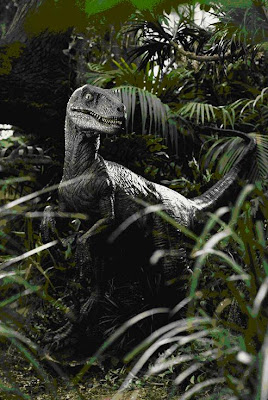 21. Raptors
21. RaptorsJurassic Park is a 1993 American science fiction thriller film directed by Steven Spielberg and based on the novel of the same name by Michael Crichton. The film centers on the fictional Isla Nublar (Incorrect spanish meant for "Cloudy Island", it would be "Isla Nublada" properly), in Costa Rica, where billionaire philanthropist John Hammond (Richard Attenborough) and a team of genetic scientists from his company have created an amusement park of cloned dinosaurs.
The wealthy billionaire and dinosaur enthusiast John Hammond (Richard Attenborough), CEO of InGen has recently created Jurassic Park; a futuristic theme park populated with dinosaurs cloned from DNA taken from fossilized mosquitoes preserved in amber. The park is situated on Isla Nublar, an island 87 miles north-west of Costa Rica; for security purposes, the island is surrounded by fifty miles of electric fence, and the dinosaurs have had their chromosomes altered to make them all female to prevent reproduction.
After an incident in the park, where a worker is fatally savaged by a Velociraptor, Hammond is advised by his lawyer Donald Gennaro (Martin Ferrero) to have two experts sign off on the island for the benefit of health and safety. To that end, Hammond invites paleontologist Alan Grant (Sam Neill) and paleobotanist Ellie Sattler (Laura Dern) along with Dr. Ian Malcolm (Jeff Goldblum), a chaotician, and Hammond's grandchildren—Timothy "Tim" Murphy (Joseph Mazzello) and Alexis "Lex" Murphy (Ariana Richards)—to Jurassic Park, in order to convince his lawyers the park is safe. The group is sent into the park as part of a safari experience to observe most of the animals. Hammond, meanwhile, observes his guests along with Head Technician Ray Arnold (Samuel L. Jackson) and his Head of Security, Robert Muldoon (Bob Peck).
However, it transpires that one of the computer programmers, Dennis Nedry (Wayne Knight), is in the employ of BioSyn, a corporate rival of InGen, and has been paid a substantial price to steal fertilized dinosaur embryos. To allow the theft, Nedry infects the park's security measures with a computer virus to allow him access to the embryo storage, inadvertently deactivating the electrified fences containing the dinosaurs. The rest of the group, who have been stranded in the park due to the system shutdown, are attacked by the Tyrannosaurus escaping from its paddock; Gennaro is killed and Malcolm is badly injured. Grant survives and escapes with the children into the park. Nedry flees with his prize, but his jeep gets stuck, and while trying to winch it out Nedry is blinded and eventually killed by an escaped Dilophosaurus. The embryos are lost.
With the virus affecting the entire park's systems, Hammond recommends a total shutdown of the park's systems. He, along with Sattler, Arnold, Muldoon and Malcolm, shuts down the park's system and retreats to the emergency bunker, from where Arnold heads to the maintenance compound to reboot the system. When he doesn't return, Muldoon and Sattler head for the compound; on the way, they pass the raptor paddock, and discover the raptors (whose fence wasn't shut off by Nedry but was affected by the park-wide shut-down) have escaped. At the same time, Grant and the children discover a nest full of hatched eggs; the dinosaurs are breeding. Grant theorizes this is due to using frog DNA to fill in gaps in the dinosaur gene sequence, as some frogs are able to change gender in a single-sex environment.
As Muldoon and Sattler proceed to the maintenance compound, Muldoon realizes they are being hunted by Velociraptors. The pair split up; Muldoon goes after the raptors, while Sattler heads for the maintenance shed. She manages to reactivate the park's systems (narrowly escaping a Velociraptor hiding inside the shed, which has killed Arnold) inadvertently at the same time, Tim, Lex and Grant climb the electrified fence out of the park's animal zone and Tim is nearly killed upon the reactivation of the electricity; meanwhile, Muldoon is ambushed and killed by the Velociraptors. Grant and the kids head for the visitor's centre; he leaves the kids alone in the kitchen while he reunites with Sattler and the others. The kids find that two Velociraptors have entered the visitor centre, but they are able to evade the dinosaurs, reunite with Grant and Sattler and get the park's security systems working from the control room. Grant contacts Hammond and tells him to call the mainland for rescue, but the two raptors find the group and attack.
The group flees, only to be cornered in the entrance hall by the Velociraptors, who get ready to pounce. As all seems lost, the Tyrannosaurus breaks into the hall and seizes one of the raptors in its jaws, killing it. The second raptor charges the T-Rex as Sattler, Grant and the kids run for safety as the two dinosaurs fight; they are rescued by Malcolm and Hammond, who have fled the emergency bunker in a Jeep, where Grant tells Hammond he will not endorse Jurassic Park, a decision with which Hammond agrees. As they drive away, the Tyrannosaurus finishes off the Velociraptor and roars in triumph.
The group reaches the helipad, where they are evacuated from the island. As their helicopter flies across the ocean back to the mainland, Grant sees a flock of pelicans flying past, reminders of the connection between birds and dinosaurs.
The Velociraptor is portrayed as the film's antagonist. The animal's depiction was not based on the actual dinosaur genus in question (which itself was significantly smaller), rather the related (and larger) genus Deinonychus, which had been synonymised with Velociraptor by Gregory S. Paul in 1988. Crichton's writing followed this, but by the time production of the film took place, the idea had been dropped by the scientific community. Coincidentally, before Jurassic Park's theatre release, the similar Utahraptor was discovered, though was proved bigger in appearance than the film's raptors; this prompted Stan Winston to joke, "We made it, then they discovered it." For the attack on character Robert Muldoon, the raptors were played by men in suits. Dolphin screams, walruses bellowing, geese hissing, an African crane's mating call, and human rasps were mixed to formulate various raptor sounds.Following discoveries made after the film's release, most paleontologists theorized that dromaeosaurs like Velociraptor and Deinonychus had feathers.
All monster info from Wikipedia
See Also: The 100 Greatest Monsters From Movies And Television #31 - #40/ The 100 Greatest Monsters From Movies And Television #41 - #50 / The 100 Greatest Monsters From Movies And Television #51 - #60 / The 100 Greatest Monsters From Movies And Television #61 - #70 / The 100 Greatest Monsters From Movies And Television #71 - #80 / The 100 Greatest Monsters From Movies And Television #81 - #90 / The 100 Greatest Monsters From Movies And Television #91 - #100